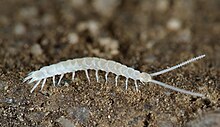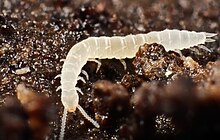Symphyla
| Symphyla Temporal range: Mid Cretaceous to Present
| |
|---|---|

| |
| Scutigerella sp. (Scutigerellidae) | |

| |
| Scollopendrellid symphylan (Scolopendrellidae) | |
| Scientific classification | |
| Domain: | Eukaryota |
| Kingdom: | Animalia |
| Phylum: | Arthropoda |
| Subphylum: | Myriapoda |
| Class: | Symphyla Ryder, 1880 |
| Families | |
Symphylans, also known as garden centipedes or pseudocentipedes, are soil-dwelling
Symphyla are primarily
Description

Symphyla are small, cryptic myriapods without eyes and without pigment.[4] The body is soft and generally 2 to 10 millimetres (0.08 to 0.4 in) long, divided into two body regions: head and trunk.[4] An exceptional size is reached in Hanseniella magna, which attains lengths of 25 to 30 mm (1.0 to 1.2 in).[11]
The head has long, segmented
The trunk comprises 15–24 segments, which are protected by overlapping dorsal plates. Ten or twelve segments bear legs. The first segment is large and usually provided with a pair of legs, the last segment is slender, lacks legs, and possesses a pair of cerci. Symphylans have been reported as living up to four years, and moult throughout their life.[2] Immature individuals have six pairs of legs on hatching, but they add an additional pair at each moult until the adult instar, which usually has twelve pairs of legs.[12][13] This mode of development is known as hemianamorphosis.[14] Although most adult symphylans have twelve leg pairs, the first pair is absent or vestigial in some species (e.g., those in the genus Symphylella), so adults in some species have only eleven leg pairs.[15][16]
Symphylans have several features linking them to early insects, such as a labium (fused second maxillae), an identical number of head segments and certain features of their legs.[1] Each pair of legs is associated with an eversible structure, called a "coxal sac", that helps the animal absorb moisture, and a small stylus that may be sensory in function. Similar structures are found in the most primitive insects.

Symphylans breathe through a pair of
The genital openings are located on the fourth body segment, but the animals do not copulate. Instead, the male deposits 150 to 450 packages of sperm, or spermatophores, on small stalks. The female then picks these up in her mouth, which contains special pouches for storing the sperm. She then lays her eggs, and attaches them to the sides of crevices or to moss or lichen with her mouth, smearing the sperm over them as she does so. The eggs are laid in groups of eight to twelve.[2]
Symphylans also have spinnerets whose secretions turn into a silk-like thread.[18] One fossil species, Symphylella patrickmuelleri, was found preserved in Burmese Amber releasing long threads of silk.[19] The silk plays a role in reproduction: the male deposits up to 450 spermatophores on stalks of silk.[20] Symphylans have also been reported releasing silk as a defense[21] and to suspend themselves in the air.[2]
Fossil record and evolution
The symphylan fossil record is poorly known, with only five species recorded, all placed in living genera. The oldest records of both families are found in Burmese amber from the middle Cretaceous, approximately 99 million years ago. As a result, both families are thought to have diverged before the end of the Mesozoic Era.[22][23][24]
Despite their common name, morphological studies commonly place symphylans as more closely related to
References
- ^ ISBN 978-1-4020-3182-3.
- ^ ISBN 978-0-03-056747-6.
- ^ "ITIS - Report: Symphyla". www.itis.gov. Retrieved 2024-02-28.
- ^ a b c d Penny Greenslade (2002-03-31). "Class: Symphyla". Australian Faunal Directory. Australian National University. Archived from the original on 2015-09-24.
- ^ H. Boyle (1981). "Symphyla control in young plant cane". Cane Growers' Quarterly Bulletin. 44: 115–116.
- ^ D. A. H. Murray & D. Smith (1983). "Effect of Symphyla, Hanseniella sp., on establishment of pineappes in south-east Queensland". Queensland Journal of Agricultural Science. 40: 121–123.
- S2CID 89444581.
- .
- ^ Eberhard, S.M. & Spate (1995). "Cave Invertebrate Survey; toward an atlas of NSW Cave Fauna". A Report Prepared Under NSW Heritage Assistance Program NEP. 94: 765.
- ^ D. E. Walter, J. C. Moore & S. Loring (1989). "Symphylella sp. (Symphyla: Scolopendrellidae predators of arthropods and nematodes in grassland soils". Pedobiologia. 33: 113–116.
- ISBN 978-0122268656. Archived from the original(PDF) on 2014-02-21.
- ^ "Garden Symphylans". Integrated Pest Management on Peppermint-IPMP3.0. Oregon State University. Archived from the original on 2007-08-03. Retrieved 2007-07-02.
- ^ "Symphylans". Entry: Symphylans. Encyclopedia of Arkansas. Retrieved 2021-05-29.
- S2CID 21401688. Retrieved 25 August 2020.
- OCLC 812207443.
- ISBN 978-0-12-384720-1, retrieved 2022-02-28
- ^ BIOLOGICAL SCIENCE FUNDAMENTALS AND SYSTEMATICS - Volum III
- JSTOR 10.7591/j.ctvn1tb6g.14.
- ISSN 0195-6671.
- ^ "Symphylans". Encyclopedia of Arkansas. Retrieved 2023-05-02.
For reproduction, males do not copulate with the female. Rather, they deposit 150 to 450 sperm packets (spermatophores) on top of short stalks of silk on the ground.
- ^ Schulze, L. (Jan 1975), Structure, composition and properties of spun products
- .
- ISBN 978-90-04-15611-1.
- ISSN 1809-127X.
- ^ PMID 19944188.
- PMID 18782622.
- PMID 15579388.
- PMID 37215163.
Further reading
- C. A. Edwards (1990). "Symphyla". In Daniel L. Dindal (ed.). Soil Biology Guide. New York: Wiley. pp. 891–910. ISBN 978-0-471-04551-9.
- U. Scheller (1961). "A review of the Australian Symphyla (Myriapoda)". Australian Journal of Zoology. 9 (1): 140–171. .
- U. Scheller (1982). "Symphyla". In Sybil P. Parker (ed.). Synopsis and Classification of Living Organisms. New York: McGraw-Hill. pp. 688–689. ISBN 978-0-07-079031-5.
- R. J. Tillyard (1930). "The evolution of the class Insecta". Papers and Proceedings of the Royal Society of Tasmania. 1930: 1–89.
External links
 Data related to Symphyla at Wikispecies
Data related to Symphyla at Wikispecies
